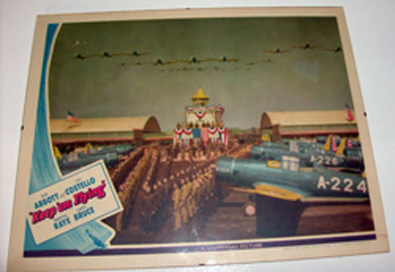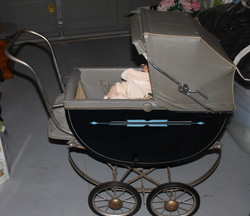 |
|
|||
 |
 |
|||
RINKER ON COLLECTIBLES — Column #1421 Copyright © Harry Rinker, LLC 2014
Questions
and Answers QUESTION: I have two movie posters, each measuring 14 inches x 11 inches. The first is from the movie “Thunderbirds,” starring Gene Tierney. The second is from “Keep ‘Em Flying,” starring Abbott and Costello. The posters have slight wear. Their overall condition is good. What is the value of my posters? – M, Reading, PA, Email Question ANSWER: There are four basic types of film posters: (1) lobby card, (2) teaser poster, (3) character poster, and (4) final poster. The final poster was prepared in many sizes including the standard one sheet (27 inches by 41 inches, later 27 inches by 40 inches), display (also known as half-sheets), and window cards (14 inches by 22 inches). Your posters are lobby cards, which traditionally measured 11 inches by 14 inches after 1930. Lobby cards are issued in sets of six, eight, and twelve. Sets of eight are the most common. The set included a title card and seven cards featuring scenes from the movie. They were placed in holders in the lobby in advance of a film’s showing. You have one lobby card from the eight card set for each movie.
“Thunderbirds” (Twentieth Century Fox Film Corporation; premiered October 19, 1943) is subtitled “Soldiers of the Air.” It was shot in Technicolor at an Army Air Force Base in Arizona. Gene Tierney, Preston Foster, and John Sutton star. The plot contains a love triangle involving the flying instructor (Preston), cadet (Sutton) and Tierney and the appropriate crash and rescue scenes. (See: http://en.wikipedia.org/wiki/Thunder_Birds_%281942_film%29)
“Keep ‘Em Flying” (Universal Pictures; premiered November 28, 1941) was the third film in a series of peacetime draft service films starting Abbott and Costello, a popular comedy team. The other two films were “Buck Privates” and “In the Navy.” “Keep ‘Em Flying” was the motto of the Army Air Corps. Abbott and Costello play two bungling ground crewman in the film. (See: http://en.wikipedia.org/wiki/Keep_%27Em_Flying). In researching the value of lobby cards on the internet, it is essential to distinguish between modern photographic reproductions and period lobby cards. Size is one clue. Many reproductions measure 8 x 10 rather than 11 x 14. A glossy surface is another clue. Period lobby cards had a matte finish. Price is the final clue. If the asking price is below $15.00, be suspicious. The value of individual lobby cards has risen dramatically as the value of one sheet posters has skyrocketed. There are several keys to value. The first is the collecting popularity of the actors and actresses that appeared in the movie. Tierney and Abbot and Costello were big box office attractions in the 1940s. However, collecting interest is fading rapidly. Second, is the film one of the seminal films in the career of the actor or actress? “Keep ‘Em Flying” does not contain the same legendary cache as “Buck Privates,” “Abbot and Costello Meet the Invisible Man,” or “Abbott and Costello Meet Frankenstein.” Tierney is best remembered for her roles in “Heaven Can Wait,” “Laura” and “Leave Her to Heaven.” Third, surface condition is important. Any damage impacts value. Fourth, any enhancement, such as matting and/or framing, must be discounted. Finally, crossover value is a factor. Both lobby cards have appeal to military collectors and Army Air Force collectors. Your lobby cards are in very good condition based on my evaluation of the photographs that accompany your email. The lobby cards are scenic cards from the set. When sold individually, the title card in a set usually commands the strongest price. The value of each of your lobby cards is between $20.00 and $25.00. QUESTION: I have a Newhouse No. 4 1/2 wolf trap and a No. 5 bear trap. What is their value? -- R, State College, Pennsylvania. ANSWER: Whenever I need information about traps, I consult Blaise Andreski and Tom Parr’s “The Trap Collectors Guide: Current Pricing and Other Practical Information,” published by the authors in 2012 and available from the Sterling Fur Co. by calling (330) 949-3763 or Tom Parr at (614) 878-6011. Sewell Newhouse (born 1806 in Vermont) made his first steel trap at the age of 17. In 1849, Newhouse joined John Humphrey Noyes’s Oneida (NY) Community. In 1855, demand for Newhouse traps led to the creation of a trap manufacturing factory within the Oneida community. Although Newhouse passed away in 1888, Newhouse traps continued to be made. In 1925, the Oneida Community sold its trap-making division to the Animal Trap Company of Lititz , Pennsylvania, which continued manufacturing Newhouse traps through 1976. Value of any Newhouse trap depends on several factors. The first is age. Older traps generally command a higher value. The company changed its manufacturer’s trademark and trap pan mark several times. The second is parts. All the parts have to be period for a trap to achieve maximum value. The third factor is condition. Although collectors acknowledge that most traps are found in used condition, traps with excess rust and pitting are discounted in value. Look at the pan on your No. 5 bear trap. If it says Oneida Community, it dates from 1893 to 1911, Oneida Community with a patent date from 1911 to 1925, and Animal Trap Company from 1925 to 1976. Andreski and Parr value both a No. 5 trap in good condition with an Oneida Community patent date pan at $525.00 and an ATC pan at $525. The 4 1/2 wolf trap is valued at $175.00. Price guide values are only guides. Internet asking prices for both traps differed by over 200 percent. While much of the difference can be explained by condition, the difference also reflects each seller’s subjective consideration as to the worth of the trap. The obvious conclusion is that if buying, it pays to comparison shop.
ANSWER: The following information is from “Rinker on Collectibles” Column #1163 (2009): “In 1919 Hedstrom bought an interest in the Union Manufacturing Company, established two years earlier by William Carlson, Oscar E. Fowelin, and Ernest Johnson. The company made reed-bodied baby carriages and hoods. Hedstrom and Union merged in 1922 to become Hedstrom Union Company. In 1928, Children’s Vehicle Company of Templeton was acquired. Hedstrom Union Company leased a plant in Fitchburg in 1936. Labor difficulties in 1950 resulted in the closing of the Gardner and Fitchburg facilities. The company moved its manufacturing and business offices to Dotham, Alabama and Bedford, Pennsylvania.” The above information indicates that your baby carriage was made between 1936 and 1950. The design and decorative motif suggest a late 1930s or early 1940s manufacturing date. Doll collectors are the primary purchasers of antique and collectible baby carriages. They use them to display their larger dolls. There is no reuse market for these carriages since they do not conform to modern safety standards. The stylish design of your Hedstrom baby carriage and its condition suggest a secondary resale market value of between $45.00 and $55.00. The Fitchburg, Massachusetts, Hedstrom is not to be confused with Hedstrom Plastics, a manufacturer of rubber play balls and other toys located in Ashland, Ohio. TRIVA QUESTION: Ashland, Ohio, was known as the _________ capital of the world? QUESTION: I own a Champion Complete Accountant, manufactured by the Champion Register Company of Cleveland, Ohio. How old is it, what was it used for, and what is its value? – DK, Baker City, OR, Email Question ANSWER: The Maine Maritime Museum’s website pictures a Champion Complete Accountant machine, circa 1908, suggesting it “would be of benefit to a shipyard paymaster with numerous cash payoffs to manage.” The machine, not a calculator, weighs over 100 pounds and has a system of shelf units by which individual wages could be organized, kept, and distributed. See: http://www.mainemaritimemuseum.org/collection/notes-from-the-orlop/adding-it-up/. Your Champion Complete Accountant is an office oddity. It is not a calculator, and it is not a safe. Its weight and lack of attractiveness (it is box-like in appearance) are value deterrents. Its curiosity/conversation value is between $25.00 and $40.00. TRIVA QUESTION ANSWER: The balloon capital of the world.Harry L. Rinker welcomes questions from readers about
collectibles, those mass-produced items from the twentieth and twenty-first centuries.
Selected letters will be answered in this column.
Harry cannot provide personal answers.
Photos and other material submitted cannot be
returned.
Send your questions to: Rinker on Collectibles, 5955 Mill
Point Court SE, Kentwood, MI 49512.
You also can e-mail your questions to
harrylrinker@aol.com.
Only e-mails containing a full name and mailing address
will be considered.
You can listen
and participate in
WHATCHA GOT?, Harry’s
antiques and collectibles radio call-in show, on Sunday mornings between 8:00 AM
and 10:00 AM Eastern Time.
If you
cannot find it on a station in your area,
WHATCHA GOT?
streams live on the Internet at www.gcnlive.com.
SELL, KEEP OR TOSS?: HOW TO DOWNSIZE A HOME,
SETTLE AN ESTATE, AND APPRAISE PERSONAL PROPERTY
(House of Collectibles, an imprint of Random House Information Group, $17.99),
Harry’s latest book, is available at your favorite bookstore and via
www.harryrinker.com.
|
||||


 QUESTION: I own a Hedstrom baby carriage that belonged to my mother’s sister-in-law. The label reads “HEDSTROM, Fitchburg, MASS.” The carriage has spoked wheels, a crescent moon-shaped spring, a semi-circle metal side, and folding canvas top. What is it worth? – HB, Ocala, FL, Email Question
QUESTION: I own a Hedstrom baby carriage that belonged to my mother’s sister-in-law. The label reads “HEDSTROM, Fitchburg, MASS.” The carriage has spoked wheels, a crescent moon-shaped spring, a semi-circle metal side, and folding canvas top. What is it worth? – HB, Ocala, FL, Email Question